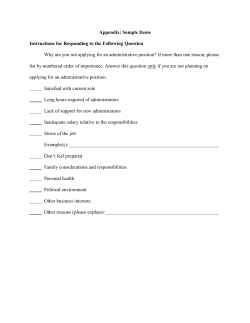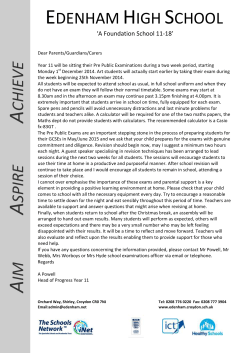
Part II Objectives
Part II Objectives Describe how policies and procedures are used Identify different types of P & P Describe the purpose and components of a Policy on Policies Explain the approval and review process for policies and procedures Describe suggestions for writing policies and procedures When to Write or Revise P & P Starting new or when changes occur When required by legislation/regulation Policies must take into account various levels of legislation/regulation which impact health care delivery When to Write P & P Examples: – Federal government establishes health care legislation and funding, e.g., Title X regs – State government takes action in accordance with Federal legislation, e.g., state statutes, admin. code, program regulations – Local government plans for mandated services and decides whether to offer non-mandated services. Decisions are made at several levels. Use of P & P Administrators manage in accord with policies Administrators design procedures to carry out policies Examples – fiscal procedures – program protocols – purchasing procedures When to Write P & P Examples cont’d: – Levels of decision-making: • • • • Board of County Commissioners Board of Health Local Health Department/Health Director Program Area These decisions form the basis for policies and procedures When to Write P & P Examples: – Federal level--HIPAA, OSHA – State level--Nurse Practice Act, Bd of Pharmacy regulations, program policies – Local level--County ordinances, various county-wide policies – Agency level--P & P to carry out the work of the agency Types of Policies and Procedures Agency Policies – a broad description of what agency does and why – include the objectives, rules, and regulations which guide agency activities and direct allocation of resources – should be consistent with agency mission statement, strategic plan & community assessment Types of Policies and Procedures Program Policies – describe the what and why as they apply to individual programs – include the objectives and rules which direct a specific program focus and activities – should be consistent with overall agency policies Types of Policies and Procedures Procedures – describe in detail how and by whom the work is to be done – should be consistent with policy statements Protocol – the plan for processing patients through a given program – a treatment plan used by mid-level practitioners Types of Policies and Procedures Standing Orders – the framework for Registered Nurses to assess and treat disease while practicing in local health department settings – signed instructions of a physician which outline the medical assessment, appropriate testing, and treatment performed on behalf of the physician – standardize the clinical care practiced – require no medical decision-making by nurse Policy on Policies A policy that governs the policy development process Describes the process used in your agency to develop policies and procedures P on P should address the following components: – who initiates the process – who writes – format--type face, margins, headings Policy on Policies Components, cont’d: – identification system, e.g., by name or number – organization system, manuals vs. stand alone policies, electronic, intranet, internet – writing style – approval process – review and revision cycles Policy on Policies Components cont’d: – education and distribution – archiving Sample Policy on Policies in handouts Approval and Review Process Policy on Policies should provide – direction on who approves policies – define review and revision cycles Approval – policy should be signed by the individual approving the policy – date of approval should be recorded Approval and Review Process Review and revision cycles – may be the same for all P & P – may be different for groups or categories of P&P Recommend P & P be reviewed and revised as needed and at least annually Policy Development Process Suggested steps: 1. Define the issue, problem or task 2. Determine responsibility for writing 3. Involve all disciplines who will be affected and are involved in carrying out the program 4. Involve medical consultant when developing policies related to clinical services Policy Development Process Steps cont’d: 5. Use an agreed upon template or format 6. Write draft of the policy or procedure 7. Review and analyze the draft 8. Revise the draft as necessary 9. Do final review Use of P & P Boards adopt policies to guide the work of an organization Boards govern by policy Examples of policies adopted by Boards – fiscal policies – program policies – personnel policies Policy Development Process Steps, 10. 11. 12. 13. cont’d: Make final revisions Adopt the policy or procedure Distribute policy or procedure Educate staff Policy Development Process Steps, cont’d: 14. Implement the policy/procedure 15. Conduct on-going evaluation/revision per policy on policies Policy Development Process REMEMBER: – – – – – – Some policies should be reviewed by: County Attorney County Manager Personnel Officer Medical Advisor Other as appropriate
© Copyright 2025





















